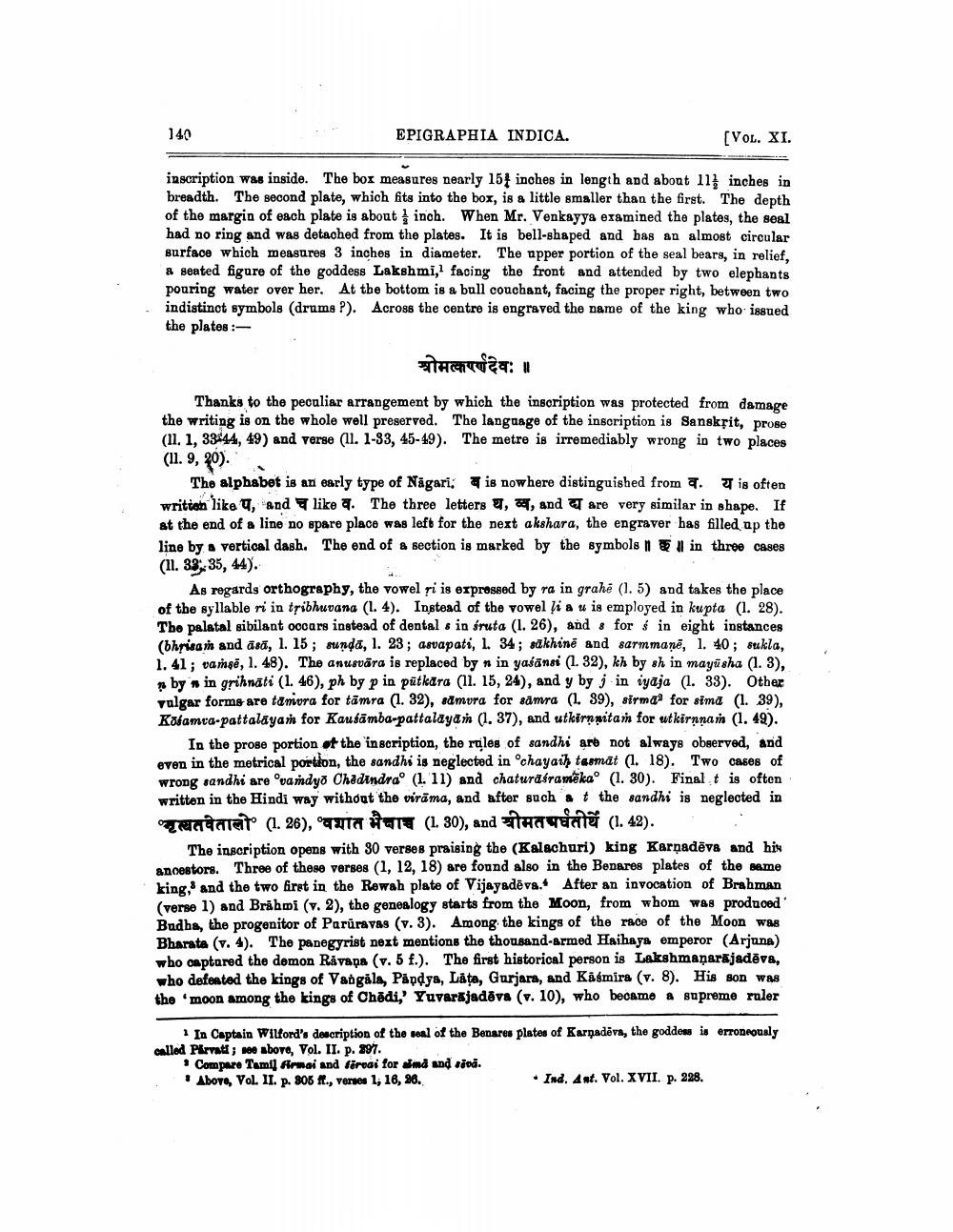________________
140
EPIGRAPHIA INDICA.
(VOL. XI.
inscription was inside. The box measures nearly 154 inches in length and about 11inches in breadth. The second plate, which fits into the box, is a little smaller than the first. The depth of the margin of each plate is about inch. When Mr. Venkayya examined the plates, the seal had no ring and was detached from the plates. It is bell-shaped and has an almost circular surface which measures 3 inches in diameter. The upper portion of the seal bears, in relief, a seated figure of the goddess Lakshmi, facing the front and attended by two elephants pouring water over her. At the bottom is a bull couchant, facing the proper right, between two indistinct symbols (drums?). Across the centre is engraved the name of the king who issued the plates :
श्रीमत्करणदेवः ।
Thanks to the peculiar arrangement by which the inscription was protected from damage the writing is on the whole well preserved. The language of the inscription is Sansksit, prose (11. 1, 33-44, 49) and verse (II. 1-83, 45-49). The metre is irremediably wrong in two places (11. 9, 20).
The alphabet is an early type of Nagari: is nowhere distinguished from a. U is often writion like U, and like a. The three letters 4, 4, and are very similar in shape. If at the end of a line no spare place was left for the next akshara, the engraver has filled up the line by a vertical dash. The end of a section is marked by the symbols in three cases (11. 33, 35, 44).
As regards orthography, the vowel ri is expressed by ra in grahi (1.5) and takes the place of the syllable ri in tribhuvana (1.4). Instead of the vowel si a u is employed in kupta (1. 28). The palatal sibilant occurs instead of dental s in sruta (1. 26), and 3 for $ in eight instances (Chrisam and asā, 1. 15; sunda, 1. 23; asvapati, 1. 34; sakhine and sarmmanē, l. 40; sukla, 1. 41; vanşe, 1. 48). The anusvāra is replaced by n in yaśānsi (1. 32), kh by sh in mayūsha (1. 3),
by in grihnati (1. 46), ph by p in putkara (11. 15, 24), and y by j in iyaja (1. 33). Other vulgar forms are tamora for tāmra (1. 32), edmura for sämra (1. 89), sirmay for sima (1. 39), Kodamra-pattalāyan for Kausāmba-pattalayan (1. 37), and utkirnpitam for utkirnnam (1. 49).
In the proge portion of the inscription, the rules of sandhi are not always observed, and even in the metrical portion, the sandhi is neglected in chayaih tasmat (1. 18). Two cases of wrong sandhi are 'vandyo Chadındrao (1. 11) and chaturdframēkao (1. 30). Final.t is often written in the Hindi way without the virama, and after such a t the sandhi is neglected in Thadarat (1. 26), TA #1 (1.30), and havet (1. 42).
The inscription opens with 30 verses praising the (Kalachuri) king Karnadēvs and his ancestors. Three of these verses (1, 12, 18) are found also in the Benares plates of the same king, and the two first in the Rewah plate of Vijayadeva. After an invocation of Brahman (verse 1) and Brähmi (v. 2), the genealogy starts from the Moon, from whom was produoed Budha, the progenitor of Paruravas (v. 3). Among the kings of the race of the Moon was Bharata (v.4). The panegyrist next mentions the thousand-armed Haihaya emperor (Arjuna) who captared the demon Råvapa (v. 5 f.). The first historical person is Lakshmanarajadēva, who defented the kings of Vangala, Pandya, Lata, Gurjara, and Kasmira (v. 8). His son was the moon among the kings of Chādi,' Yuvarajadēvs (v. 10), who became a supreme ruler
1 In Captain Wilford's description of the seal of the Benares plates of Karnadēva, the goddon is erroneously called Parvati; see above, Vol. II. p. 297.
• Compare Tamil firmai and förvai for md and ripa. Above, Vol. II. p. 806 ft., verres 1; 16, 26.
• Ind. Ant. Vol. XVII. p. 228.




